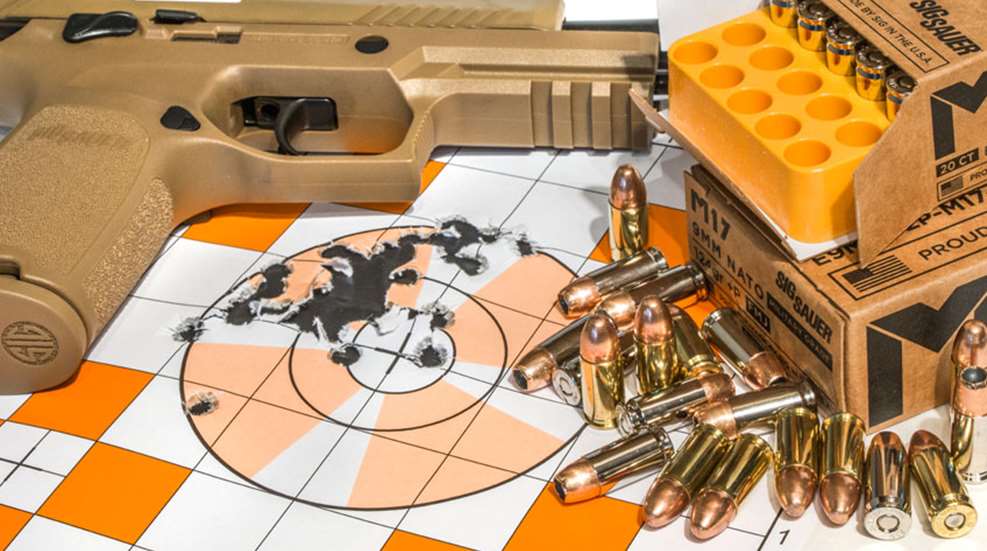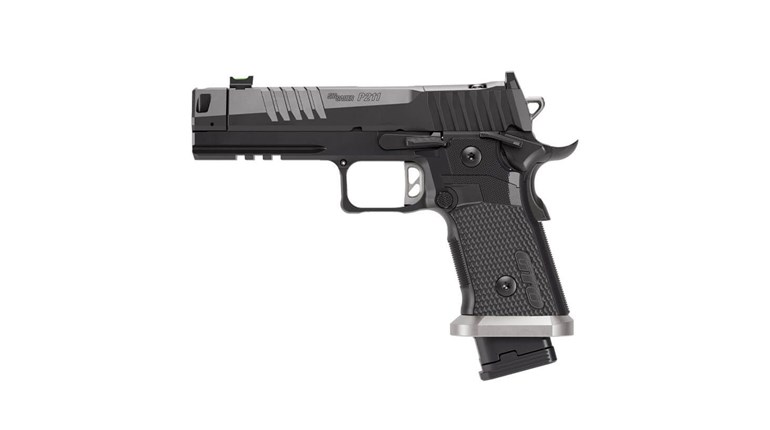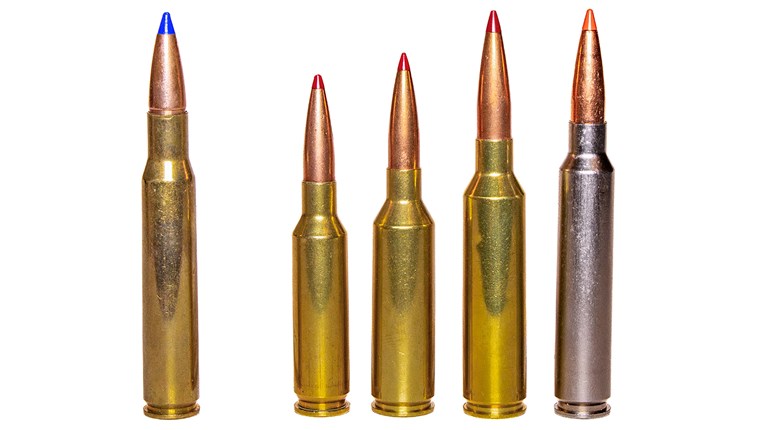
SIG Sauer’s M17 9 mm ammunition offers consumers military-grade performance in FMJ and hollow-point configurations.
To complement its P320/M17—the duty handgun chosen by the U.S. Army—SIG Sauer is now offering M17 ammunition. This ammo is loaded to military specifications. (Just so you know, there are a variety of ammunition specifications used by the military. The particular specification SIG Sauer conforms to with its M17 ammo does not include waterproofing.) The two 9 mm M17 loads being offered are a 124-grain, V-Crown hollowpoint and a traditional, 124-grain FMJ bullet. Both are loaded to +P velocities, as specified by SAAMI (Sporting Arms and Ammunition Manufacturer’s Institute).
The idea behind M17 ammunition is to offer civilian consumers military-grade ammunition for practice and self-defense that delivers the same velocity, recoil impulse and point-of-impact. Practice and carry ammunition with identical performance characteristics is a great idea, but nothing new; several ammunition manufacturers have done it for years. The difference with the SIG Sauer M17 ammo is that you’re getting the same +P performance with both loads, which are loaded to stringent military specs.
Admittedly, it’s also kind of cool that you can have a handgun just like our military relies on, and load it with ammunition built to perform to military specs. Given that many who will purchase the P320/M17 are doing so because it’s the chosen handgun of our armed forces, having ammunition branded similarly is probably a great marketing idea.
The first question is, does this ammunition actually deliver as advertised, so you can train and carry with identically performing ammo? The second is, does the carry load—the 124-grain V-Crown—deliver a level of terminal performance conforming to what is expected from modern defensive-handgun ammunition. There is, as they say, only one way to know—test it.
For starters, the M17 9 mm 124-grain V-Crown load was tested in 10-percent ordnance gelatin, with two layers of denim placed in front of the gelatin blocks. Five rounds were tested, and the average penetration depth was 14 inches. Weight retention was 100 percent across the board, and the bullets expanded to an average of .56 inches, or 1.57 times their original diameter. That’s better than average when it comes to 9 mm defensive-handgun ammunition.
The next test involved a velocity/recoil/point-of-impact comparison between the V-Crown and FMJ M17 loads. Right off, I noticed the FMJ load had more felt recoil. However, at 15 yards point-of-impact was identical. Chronograph testing revealed why. The 124-grain V-Crown load had an average velocity of 1,159 fps and the 124-FMJ load averaged 1,250 fps. That’s a difference of 91 fps, and from a recoil standpoint, a variance of 13 percent. Not exactly what you would expect from ammunition intended to deliver identical performance.
However, understand all ammunition is loaded to perform within a performance window. When mass producing ammunition, there are going to be variances from lot to lot because of component variation. However, a velocity variance of about 8 percent is a little extreme. I reached out to the ammunition specialists from SIG Sauer and asked them to explain.
The answer is much like what I expected. Like SAAMI, SIG Sauer allows for certain tolerances in ammunition performance. (SAAMI allows for a variation of plus or minus 90 fps in 9 mm +P ammo.) It’s the only practical and realistic way to mass-produce ammunition (or anything else for that matter). Because of this, it’s possible to receive one lot of ammunition that’s loaded on the mid to low end of the tolerance scale, and another lot that is loaded on the upper end. SIG Sauer suspected this was the case with the two loads—lot numbers—I received. So, I asked SIG to send samples from other lots, and it did.
However, before getting into how the different lots performed, let’s discuss lot numbers, where to find them and what they mean. A lot number identifies a batch of ammunition, all made at the same time, with the exact same components. This allows an ammunition manufacturer to track ammo and identify ammo if a problem is found with it. You can find the lot number printed on the box somewhere. Initially, I provided the company with a number printed on the inside flap of the box. Unfortu-nately, this was not the lot number; it was the box number. SIG Sauer impresses both numbers on the inside flap.
I tested the two additional lots of SIG Sauer M17 ammunition and the original lots at the same time to get a better idea of the variance that might be expected. The old and new lots of V-Crown ammunition showed a velocity variance of only 10 fps and the new lot of FMJ varied by 11 and 1 fps respectively. That’s damned consistent. The old lot of FMJ (#FKAR1915) was just as fast as it was the first time I tested it.
So, we must assume that specific lot of ammunition was built on the upper/outer edge of the allowable tolerance. Keep in mind, variation between lots of ammunition like this is not unique to SIG Sauer; you’ll likely see similar results with any mass-produced ammunition—if you happen to get the right or wrong mix of lot numbers. As an important aside, the standard velocity deviation for lots tested was, quite impressively, in the single digits.
Most importantly though, all four lots shot to the same point-of-impact at 15 yards. Yes, lot number FKAR1915 generated a bit more velocity and recoil, but on target, the bullets landed in the same place as those from the other three lots. This is good stuff that’s built to military-grade specification and loaded with a recipe specified for the SIG Sauer Academy and by a few select, non-commercial, SIG Sauer customers. It should be ideal for your P320/M17 or any other 9 mm +P-capable handgun.






































